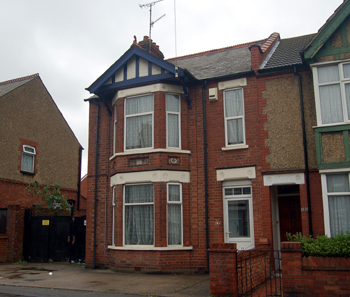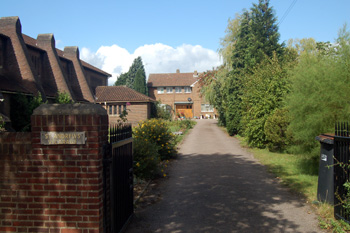
184 Biscot Road June 2010
Bedfordshire and Luton Archives and Records Service has a number of papers in the parish archive [P150] concerning two of the houses used by the clergy attending Saint Andrew's church. The first of these was purchased in 1925 for a curate of Christ Church [P150/2/4/1], but it became the first vicarage when the new ecclesiastical parish was created in 1933.
This house, called Saint Andrew's House, was at 184 Biscot Road and cost £900. The purchase of additional land at the rear, interest, tax, alterations, painting and other expenses raised this sum to £1,000 of which £50 was donated and £450 paid by the Ecclesiastical Commissioners leaving £500 outstanding. Of the alterations some were outlined by the curate in a letter [P150/2/4/1]: "I should like permission to remove the coloured fancy glass panels from the fanlight windows in the front windows and insert plain glass sheeting; also to remove the large and cumbersome mantelpiece and overmantel in the ground floor front room and insert a simple wooden mantelpiece. I shall be installing some type of gas water heater in the back kitchen".

Saint Andrew's Vicarage September 2009
In 1955 plans were drawn up by Peter Dunham, Widdup and Harrison for a new, purpose built, vicarage on land adjoining the church [P150/2/4/2-3]. The house, at the time of its construction, contained a dining room, kitchen, living room, hall, cloakroom and lobby downstairs, with four bedrooms, a box room and a bathroom upstairs. A mortgage for £1,780 was taken out with the Church Commissioners in 1957 to pay for the new vicarage [P150/2/4/4].
184 Biscot Road was sold in 1957 for £1,975 [P150/2/4/5]. A list of dilapidations drawn up in 1925 records a front room, front kitchen or dining room, back sitting room, hall, staircase and passage, front bedroom, dressing room, middle bedroom, bathroom and back bedroom. The curate's letter, quoted above, also shows there was a back kitchen and it was here, in May 1938 that the second vicar, John Manley Hawker, sadly killed himself with gas asphyxiation due to a nervous collapse.